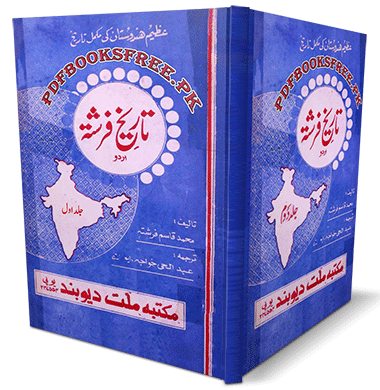Tareekh Farishta Urdu by Muhammad Qasim Farishta Pdf Free Download
Tareekh Farishta is the complete history of India, written by Muhammad Qasim Farishta and translated by Abdul Hai Khawaja. Tareekh Farishta’s book does not need any introduction due to its fame. This book is India’s most extended history, consisting of two volumes and about two thousand pages. The book contains the history of the Muslim rule of India and its political, economic, and geographical conditions in detail.
History is a mirror of civilization, which revealed the characteristics of humanity, with all their elegance and weaknesses. The evolutionary journey that human society has taken in search of the best and the valleys and destinations through which this caravan of colors and smells has passed, their history becomes “history” when it takes the form of words. But history is not just a name for repeating past events; it is an art of retrieving the past.
Obviously, history cannot be revived by counting the names of specific individuals or by writing down the circumstances of certain personalities. For this, it is necessary to look at the causes and consequences of events and examine the values of collective life that are deeply related to the rise and fall of nations and peoples.
It is not the job of a historian to present the statements of his predecessor historians in “other ways” but rather to show a picture of the causes and events and their effects from an intellectual analysis of political, economic, and geographical conditions, Which covers every aspect of the past. History is deeply connected with social sciences. A historian needs to keep a close eye on all the social sciences and their relation to the sciences of history.
If we look at the art of historiography, we can see that in the beginning, the meaning of history was to write down the living conditions of some notable people. The history of a country was written in such a way that its kings were mentioned one after another. However, the interrelationships between situations and events, their causes and consequences, and the depiction of collective life were completely ignored. Gradually this view became obsolete, and history became the story of communal life.
There are countless theories about history. Each historian has stated their idea of history separately. But there is a secret behind all these theories: if history does not unveil the truth, it is mere fiction. That is to say, the spirit of searching for the fact makes the difference between history and fables.
Interest in history has been taken up at every age. The main reason for this is that man is permanently attached to his past. He likes to look back at the endless evolutionary paths behind him. Every passing moment and memories associated with it are not only cherished but have the status of life’s necessities. Studying the past helps a great deal in understanding the present and improving the future. It is not only difficult but also impossible to make the present favorable by forgetting the past.
Another significant benefit of studying history is that it provides a great help in raising political awareness. The popularity of democracy in today’s world has placed essential responsibilities on every individual. He now chooses his rulers himself. It is as if he is playing a vital role in shaping history. The modern citizen must keep the past’s record in mind and conclude a thorough study. Obviously, in this case, history will play a significant role in developing its political consciousness.
Studying history is essential for every conscious citizen because this creates a wide range of vision and openness of mind. There is a student-teacher relationship between a citizen and a historian. History teaches a great deal. It is also the handiwork of the rise and fall of nations and the account of humanity’s caravan journey. It strengthens the connection between the past, present, and future by exposing the cultural and cultural factors.
Many historians have written about the history of Muslim rule in India. From Al-Biruni to the present day, many historians have made successful attempts to transfer past moments to the page. Tareekh Farishta is one of such successful and vital endeavors.
Muhammad Qasim Farishta ‘s living conditions are shrouded in mystery. However, this great historian has given life to many anonymous people by writing history under review, but he could not write more openly about himself. He has made some hints in his compilation that shed some light on his life situation. But these gestures do not constitute a complete life story.
The full name of the Farshta is Mullah Muhammad Qasim Hindu Shah, and the “Farishta” is his pen name. What is the origin of “Hindu Shah”? There is nothing to say about it. His father’s name was Maulana Ghulam Ali Hindushah. Like the son, the situation of the father is also hidden. Some statements of the Farishta show that Maulana Ghulam Ali was a poet.
Farishta’s hometown is Astarabad, where he was born in 1552. He came to Ahmedabad, where he started his education with royal family members as a child. When he was young, he joined the circle of employees of Murtaza Nizam Shah. After the assassination of Hussain Nizam Shah Sani, he went to Bijapur and took a job with Ibrahim Adil Sani. Here he first wrote a book on Tibb called “Ikhtiarat-e-Qasmi.”
Although Farishta was primarily engaged in his official duties, people were not unaware of his intellectual abilities. Ibrahim Adil Shah Sani was a very knowledgeable and friendly ruler. When he heard about his academic skills, especially his interest in history, he ordered Farishta to write a history of the Islamic era in India. At first, Farishta acted humbly and said that he was not qualified to perform this service, but Ibrahim did not accept this excuse and insisted.
Farishta thought that if history was written at the behest of the king, then indeed, the circumstances and events would have to be written in such a way that there would be no danger of the king’s resentment. This was not acceptable to him. This was the reason behind his humble attitude. He wanted what he wrote as a historian to be an accurate picture of reality and not be influenced by any interest.
When the king’s insistence exceeded the limit, he was compelled to pick up a pen, write a few sample pages, and present them in the king’s service. In these papers, he deliberately wrote about the circumstances of Ibrahim’s father, Ali Adil Shah I, and described the shameful incident of his assassination without any hesitation.
This courage of Farishta was admirable. If Ibrahim had wanted to, he could have read these pages and killed the Farishta because he had written in these pages everything about Abraham, which was known to everyone, but no one was talking about it.
Ibrahim read the pages and paid more attention to the Farishta’s realism than his father’s love and appreciated his approach, and ordered him to start writing history with such boldness. On the one hand, it shows the bravery and truthfulness of the Farishta, but on the other hand, it also shows the fairness of Ibrahim. The events of the reign of Ibrahim Adil Shah Sani have been forgotten, but his deed of writing history from “Farishta” will keep his name alive forever.
Farishta began writing this historical document in 1606 and completed it in 1611 after five years of hard work. Farishta was a very hardworking and intelligent historian. He studied all the historical material available to him before writing his history. He completed “Tareekh Farishta” using thirty-two history books. Farishta mentions his sources in the book’s preface and other chapters.
As will be seen from the study of the original book, “Thareekh Farishta” consists of twelve sections in addition to the foreword. The first eleven sections deal with the Muslim rulers of Lahore, Delhi, Deccan, Gujarat, Malwa, Khandish, Bengal, Jaunpur, Multan, Sindh, Sameer, and Malabar. And the twelfth section deals with the biographies of the Sufis of India. The 12th section has been omitted in this translation work because it differs from the rest of the book in its subject matter.
As a whole, “Tareekh Farishta” is an important historical document. Those who want to study the Islamic era in India cannot ignore it. There have been two translations of Tarikh Farshta in Urdu. One was published from Nol Kishore Press, Lucknow, and the other from Darul Tarjuma, Hyderabad. Both of these translations are literal. All that has been done is to replace Persian names and verbs with Urdu names and verbs. And in some places, it was not even considered necessary.
The sentence structure is also Persian style. Urdu temperament was not taken into account. For these reasons, the Urdu-speaking class cannot fully benefit from these translations. Only those who are proficient in the Persian language can use it. Obviously, the one who is an expert in the Persian language why did he start reading the translation? He will prefer the original anyway and take advantage of it.
Abdul Hai Khawaja has tried to bring this translation of “Tareekh Farishta” in every way closer to the contemporary style of Urdu writing. And in such a way that there was no difference in the concepts and demands of the original book. Footnotes are also provided, in which the present names of ancient cities, rivers, and their geographical conditions are also listed. Wherever Farishta has misrepresented a historical or geographical situation, it has been corrected as much as possible in the margins.
Urdu history book “Tareekh Farishta” is now available in Pakistan virtual library in a high-quality Pdf document for the study of our visitors. Check out the following links to read online or download the complete book in Pdf format to enjoy offline reading on your computer and smartphone.

